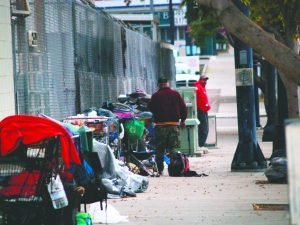BY Estephania Baez
The number of homeless people in San Diego County has positioned Southern California as the place with the fourth-largest number of homeless people in the U.S. The majority of the homeless population lives downtown, roaming the streets just feet away from the Bayfront.
The U.S. Government defines ‘homeless’ as a person who has been without a home for over a year straight or has lost his/her home several times within a three-year period, is disabled and faces barriers to employment.
According to U.S. Department of Housing and Urban Development (HUD) data, the current number of homeless people in San Diego is 8,742, versus 8,506 in 2014, equivalent to a 2.8% increase, of whom 48% sleep in the streets. According to the same report, San Diego was in 12th place nationwide in regards to homelessness in 2007. It has then climbed eight places in 8 years, which according to experts can be attributed to its closeness to the border, making it a destination both for people from elsewhere in the U.S. as well as others from Mexico and South America. The other top cities are Seattle, Los Angeles, and New York.
According to the Housing Authority of the County of San Diego, 15% of the county’s homeless suffer mental problems, among them U.S. Veterans. 17 percent of them have had alcoholism and drug abuse issues. In November of 2015, San Diego Housing Commission President Richard Gentry stated that there isn’t one single solution to the issue, but rather the implementation of several services to combat each of the issues. While some need only shelter for the night, others need medication, therapies, and others need to find relatives. More than $10 million have been invested in programs for the homeless, most of them focusing on therapy/medication for those most seriously affected.
Melinda Hohman, Director of the School of Social Work at San Diego State University, indicated that “the high cost of housing in the state of California, and particularly in Southern California, has played an important role in people ending up without a home”. She added that, today, 48% of the city’s homeless have no access to shelters due to overcrowding.
In September of this year, San Diego’s Board of Supervisors unanimously approved using more than $10 million from the California Medical Services program arguing that most of the county’s homeless suffer from a mental disability. The funds will be used to build housing over the next several hears that will also work as clinics to receive the more than 8,000 people without a home in San Diego.
In addition, programs that help the homeless are intensified during the winter season to provide them with food and blankets, and government employees work longer hours to register individuals who need to be located by relatives.
San Diego’s homeless problem has even made it to President Barack Obama’s agenda; he created a program to help the homeless that has been in place since 2010, however, the number of homeless people in San Diego has significantly increased during that same period. In spite of the multiple efforts by different organizations, public officials, and community members themselves to help the homeless, their number continues to grow for reasons unknown in America’s Finest City.